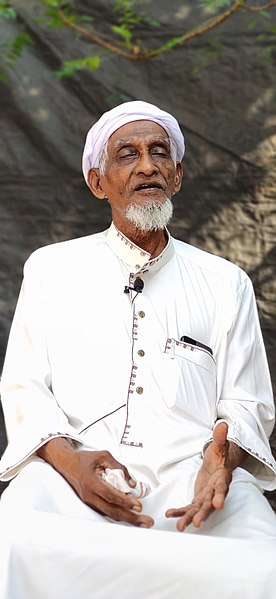
One among the teeming ranks of the many unsung heroes of environmental conservation and innovation is the figure of Ali Manikfan. Lying behind Manikfan’s austere and unostentatious bearing are eight decades of knowledge, novel inventions, and a life dedicated to the pursuit of a passionate mission. Ali Manikfan is a man of innumerable talents. He is an ecologist, a shipbuilder, a polyglot, and is one of India’s earliest marine researchers. Manikfan is particularly known for his conscientious work across a broad range of disciplines, including marine biology, ecology, cosmology, shipbuilding, and agriculture without having undergone a formal education in any of the aforementioned fields and for promoting a life of simplicity lived in tandem with nature.
Ali Manikfan was born on 16 March, 1938 to Musa Manikfan and Fida Manika in the Minicoy Island of the Lakshadweep archipelago. His father was an aameen, a court clerk, a position that placed at the family’s disposal considerable power and influence. Interestingly, Manikfan’s father and grandfather were ardent sailors, often taking ships to Kerala and Tamil Nadu for trade. Little Ali would often accompany them on these voyages and it was on these journeys that his tryst with the sea started.
After five years of homeschooling, Manikfan’s parents sent him to Kannur at the age of ten to pursue formal education at the Kannur Higher Elementary School. However, driven by the conviction that nothing could teach him better than Mother Nature, Manikfan decided to drop out of school when he was in the seventh grade, and returned to the islands. He resumed his education there rather unconventionally through an acute sense of perception for the environment and by becoming proficient in traditional knowledge. He had a penchant for languages and this gift helped him in mastering fifteen languages, including Divehi (Mahl), English, Hindi, Malayalam, Arabic, Latin, French, Russian, German, Sinhalese, Persian, Sanskrit, Tamil, and Urdu. He spent a considerable amount of time at the Imperial Lighthouse of Minicoy and learnt about a multitude of subjects from the engineers there, including lighthouse installations, light signals, climate, and satellites.
This was followed by a brief stint as a teacher in 1956 and later as a clerk for the chief civil officer of Minicoy island. However, it was in the field of marine biology that Ali Manikfan’s true interests lay. Right from early childhood he had a talent for being able to identify a variety of saltwater and freshwater fishes. Through his love for nature and a keen sense of observation, he had taught himself the ability to discern between a variety of fish species on the basis of their colour, fins, and other physical traits. This talent of his was noticed by Dr Santhappan Jones, a marine biologist and the director of Central Marine Fisheries, and she recommended him to the Central Marine Fisheries Department. Thus, he relocated to Tamil Nadu in 1960 and began working as a lab boy in the laboratory of the Central Marine Research Institute. Here, Manikfan’s aptitude for the discipline led to him playing a pivotal role in crucial discoveries in the field of marine biology. He was involved in the process of the identification and classification of more than 400 marine species through his extensive sea voyages. Remarkably, Manikfan discovered a new species of fish which was hitherto unknown in 1968. This species of fish was named Abudefduf manikfani after its finder.
During his stay in Tamil Nadu, Manikfan also applied his traditional knowledge to the field of farming. He devised a scientific technique of farming called ‘Do Nothing Farm’, which is an extraordinary method of converting barren land to a high-yielding farm without hindering the natural ecology or making use of harmful chemicals, pesticides, fertilizers, or artificial methods of irrigation.
In 1981, Ali Manikfan commenced the next chapter of his life when Irish adventurer Tim Severin sought his assistance in reconstructing an ancient trading ship, the Sohar. Severin intended to use the ship to replicate the adventures of the legendary figure of Sinbad the sailor. Ali Manikfan went to Oman where he led a team of thirty-one carpenters. The construction of the ship was carried in line with ancient Maldivian naval architectural specifications and took nearly a year to complete. Manikfan and his team were successful in building a 27-metre long ship in which no metal was used and four tons of coir were utilised to sew the planks of the hull in place. Tim Severin voyaged a distance of 9,600 kilometres on the Sohar, from Oman to China, an eight-month-long journey that he recorded in his book The Sinbad Voyage. At present, the ship is preserved in a museum in Oman.
On retirement, Manikfan purchased three acres of land on the coast of Vethalai in Tamil Nadu. It was here that he remarkably applied his traditionally acquired knowledge to engineering and automobiles. He designed windmills to channelise energy from the wind to produce electricity for his house. He also utilised his windmill power for farming his land, and soon converted an arid strip of land into a fertile farm through entirely sustainable methods. Simultaneously, the inventor in him successfully built a roller-driven moped from a single bicycle. The vehicle, which ran at a speed of 25 km/hr, was used by him to make a remarkable journey from Tamil Nadu to Delhi with his son. His unique innovation earned Manikfan a patent in India for making mopeds.
Ali Manikfan’s brilliant genius also extends into the field of astronomy. In his more recent venture, he produced a Hijri calendar based on the new moon times published by Fred Espenack. He espouses that such a lunar calendar is the most scientific way of enumerating months and years, and argues that following this calendar uniformly across the Islamic world would put an end to the situation of Muslims starting their Ramadan fasts and celebrating Eid at different times in different regions of the world. However, Manikfan’s novel calendar is yet to find acceptance within the Muslim community.
As an octogenarian at present, Ali Manikfan spends his days with his near-and-dear ones. However, he continues to disseminate his ideas to the younger generations through dialogue and discussion. He continues to be a strong champion for self-sufficiency and inflicting as little harm as possible to the natural environment. In 2021, in acknowledgement of his innovative methods in grassroot inventions in Lakshadweep, Manikfan was conferred with the prestigious Padma Shri Award.
Gunjan Mitra is an undergraduate student pursuing B.A. (Hons.) in History from Lady Shri Ram College for Women, University of Delhi. She is a firm believer of nature conservation, more specifically marine conservation. She is a certified Divemaster from P.A.D.I. She enjoys travelling and photography and hopes to be able to explore the history, culture and languages of people from all over the world.



It’s actually a nice and helpful piece of information. I’m happy that you simply shared this helpful info with us. Please stay us up to date like this. Thank you for sharing.
Thanks, I’ve just been searching for info about this topic for ages and yours is the greatest I have discovered so far. However, what about the bottom line? Are you positive concerning the source?